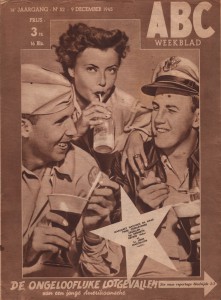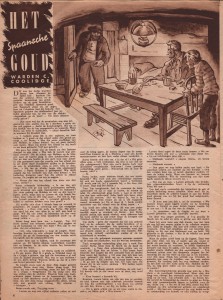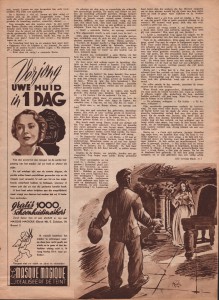Running the Bob De Moor website on just external archives would be too easy, for that reason I can count on an own archive with all kind of rare items. On top of that – from time to time – I also get contacted by sellers who have something on offer, and depending on the price I sometimes buy the item, and sometimes don’t (especially when the price is too high for what it represents). Sometimes I also refer to other parties if I think they might be able exploiting the findings in a better way for a bigger public (you’ll be able to see at least 2 examples of that in the not so far future).

Today I present you something which I found back in issue 52 of ABC Weekblad, an issue which a seller sold me privately. Released on December 1945, the issue has a short story – “Het Spaansche Goud” by Warden C. Coolidge – featuring 2 Bob De Moor drawings. The publication date is only a few months after the German unconditional surrender on 8 May 1945 and almost a year after the British Second Army liberated Antwerp on September 6th, 1944.

Warden C. Coolidge was signed with the Amsterdam based Van Holkema & Warendorf imprint, a Dutch publisher which is now part of Uitgeverij Unieboek and which you might know from their 70s book series “Paulus De Boskabouter”. I wasn’t able to dig up any relevant info regarding the (ghost)writer Warden C. Coolidge though despite looking through the archives of the publisher, then again writers often used nicknames.

But let’s have a look at the 2 drawings. They are placed on page 4 and 5 of said issue. The first drawing shows from the left to the right: the Norwegian captain Larsen, a drunken sailor, named Burns, and the cabin boy called Top. Burns wants to find a hidden Spanish treasure consisting of pure gold. The second drawing shows Burns in front of Jacinta, an ex-lover which he hasn’t seen in over 5 years (symbolic for the 5 World War II years?).
Both drawings have been signed as Bob (without date) and show a De Moor who is still working on a consistent style. You will notice that the type of lines used in the first drawing differs quite a lot, sometimes equally fat (the door, the lamp), then suddenly a mix (Burns and Top), then again a fat line only (captain Larsen). The second drawings seems more constant but that’s largely due to the darker parts in the drawing which conceal the not so consistent use of the pen. You will also notice that the way the floor is drawn is very similar to how the floor/road was drawn in this drawing from 1946 for the weekly Zondagsvriend.
De Moor would continue to deliver drawings for ABC in 1946, no trace can be found after that date. If you have more of these drawings from 1945 or 1946, don’t hesitate to contact us so we can also comment it here.
